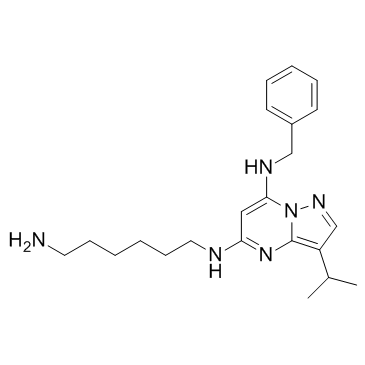BS-181

BS-181 structure
|
Common Name | BS-181 | ||
|---|---|---|---|---|
| CAS Number | 1092443-52-1 | Molecular Weight | 380.53 | |
| Density | N/A | Boiling Point | N/A | |
| Molecular Formula | C22H32N6 | Melting Point | N/A | |
| MSDS | N/A | Flash Point | N/A | |
Use of BS-181BS-181 is a highly selective CDK7 inhibitor with an IC50 of 21 nM, showing 40-fold selective over CDK1, 2, 4, 5, 6, or 9. |
| Name | 5-N-(6-aminohexyl)-7-N-benzyl-3-propan-2-ylpyrazolo[1,5-a]pyrimidine-5,7-diamine,hydrochloride |
|---|---|
| Synonym | More Synonyms |
| Description | BS-181 is a highly selective CDK7 inhibitor with an IC50 of 21 nM, showing 40-fold selective over CDK1, 2, 4, 5, 6, or 9. |
|---|---|
| Related Catalog | |
| Target |
CDK7/CycH/MAT1:0.021 μM (IC50) CDK2/Cyc E:0.88 μM (IC50) CDK1/cycB:8.1 μM (IC50) CDK4/Cyc D1:33 μM (IC50) CDK5/p35NCK:3 μM (IC50) CDK6/cycD1:47 μM (IC50) CDK9/cycT:4.2 μM (IC50) |
| In Vitro | BS-181 promotes cell cycle arrest and inhibits cancer cell growth, and growth is inhibited for all cell lines tested, with IC50 values ranging from 11.5 to 37 μM. BS-181 inhibits RB phosphorylation at Ser795 and Ser821 with an apparent IC50 of 15 μM, similar to the IC50 obtained for P-Ser2 inhibition. BS-181 treatment of MCF-7 cells leads to G1 arrest at and apoptosis[1]. BS-181 inhibits GC cell and normal gastric epithelial RGM-1 cell line growth with inhibitory concentration (IC50) ranging from 17 to 22 μM and 6.5 μM, respectively. BS-181 significantly inhibits cell migration and invasion ability in a dose-dependent manner[2]. |
| In Vivo | BS-181 (5 mg/kg, 10 mg/kg, i.p.) inhibits the growth of MCF-7 tumors in nude mice. Intravenous (i.v) and i.p administration of 10 mg/kg BS-181 shows rapid clearance[1]. BS-181 (10 mg/kg/d or 20 mg/kg/d, i.p.) significantly inhibits the growth of tumor in a dose-dependent manner compared to the control group[2]. |
| Cell Assay | Cell viability is detected using Cell Counting Kit (CCK-8 kit) according to supplier’s introductions. Briefly, BGC823 cells are seeded at 104 cells per well for 48 hours with or without BS-181. Then, the absorbance is detected at 450 nm (reference at 650 nm) in each well. |
| Animal Admin | In total, 5×106 BGC823 cells (0.1 mL) are injected subcutaneously into the flank of the mice. Tumor measurements are performed two times per week, and volumes are calculated using the formula: tumor size=(length [mm] × width2 [mm])/2. Finally, 30 mice (tumor volume 100-200 mm3) are selected and randomLy assigned into three groups. As previously described, BS-181 is prepared in 10% dimethyl sulfoxide/50 mM HCl/5% Tween 20/85% saline. Micereceive BS-181 injection (ip) twice daily at indicated doses (BS-181 [10 mg/kg/d or 20 mg/kg/d] or roscovitine [20 mg/kg/d]) for a total of 14 days. Control mice are injected with vehicles. Animal weights and tumor volume are measured each day throughout the 14-day treatment. In addition, all rats are kept for another 30 days for survival observation. Mice are injected intraperitoneally twice daily with BS-181 at 5 mg/kg or 10 mg/kg. |
| References |
| Molecular Formula | C22H32N6 |
|---|---|
| Molecular Weight | 380.53 |
| PSA | 80.27000 |
| LogP | 6.04410 |
| Storage condition | 2-8℃ |
|
~60% 
BS-181 CAS#:1092443-52-1 |
| Literature: Journal of Medicinal Chemistry, , vol. 53, # 24 p. 8508 - 8522 |
| BS181 |
| N-(6-Aminohexyl)-N-benzyl-3-isopropylpyrazolo[1,5-a]pyrimidine-5,7-diamine hydrochloride (1:1) |
| Pyrazolo[1,5-a]pyrimidine-5,7-diamine, N-(6-aminohexyl)-3-(1-methylethyl)-N-(phenylmethyl)-, hydrochloride (1:1) |
| BS-181 HCl |
| N5-(6-aminohexyl)-N7-benzyl-3-iso-propylpyrazolo[1,5-a]pyrimidine-5,7-diamine |
| BS-181 hydrochloride |
| BS-181 |
